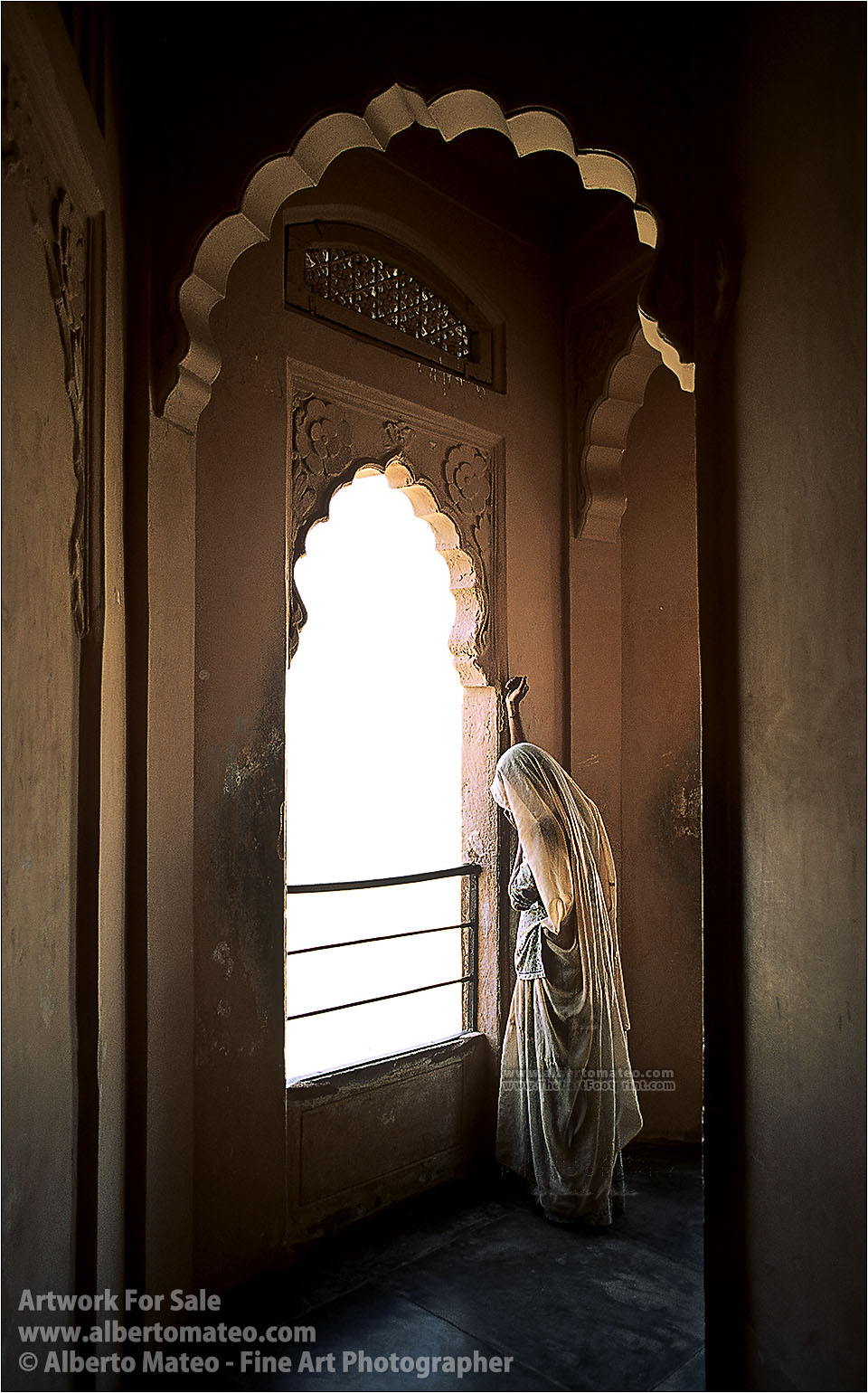Woman looking through Window. Udaipur, Rajasthan, India.
[724 words – Reading Time: 3min 50 seconds]
Travelling in Rajasthan I visited many impressive old forts and castles (all full of history), but my best picture in these locations had little to do with the antique architecture of these massive stone structures. Seeing the huge size of these constructions one may imagine how powerful were the rulers in this region of the Earth, located in the border between actual India and Pakistan, some centuries ago.

The key to this picture of an Indian woman dressed with traditional clothes is lighting. Although not completely seen in the picture, there are two sources of light, as if we were in a photography studio. The main light comes from the window in front of the woman and the fill light comes from her back, from another window that is hidden in the picture. The light from this window fills the shadows located at the back of the woman making the black shadows disappear and diminishing the contrast. With this combination of two lights plus the fill of the walls I can say I was lucky to have very nice lighting conditions.
The relaxed and natural position of the woman, with the hand softly leaning on the wall, and the delicate light that remarks even the smallest details of the cloth, are the strong points of this photograph.
To measure the light of this scene I measured inside the balcony, allowing the scene outside the window to be without detail and completely white. It was better to ensure the detail in the sharee (traditional Indian dress) of the woman. It would have been impossible to get detail both inside the building and the sky outside the window. Did I have to shoot the picture with the Matrix metering of an actual camera (like my Nikon D800) I would have to overexpose the reading, maybe compensate +2/3 or even +1, to get an accurate reading. The fact is that very bright sources of light (like this window) mislead the photometer, tricking it to think there is more light than really is.
The keys to this image are the relaxed and natural position of the woman, with the hand softly leaning on the wall, and the delicate light that remarks even the smallest details of the cloth.
If I was asked why do I like so much photographing in India, I would be able to give some arguments. One of them would be that most women even nowadays wear the traditional and colorful sharee that looks wonderful in a photograph. The clothes are so colorful and stylish that are a wonderful help in a photograph; they add a sense of old ambient, something you feel when you are travelling around in the country, but that is not always easy to transmit in a photograph, which is in the end, an excerpt, a simplification of the world we have in front of us when we are travelling. If we photographers are something, it is people who “SELECT” the most meaningful visual aspects of the scene we see and are able technically to register those meaningful aspects of a place or event, and only them. We have to center on them and forget the rest. The most effective pictures are the simplest ones, but it takes time and effort to be able to develop a mental model to discern what can be registered with a camera and what can be transmitted in a meaningful way to a spectator.
Today’s prime lenses are no better than they were in the year 2000, but zooms (variable focal length lenses) have improved optically a lot, and are cheaper.
Did I have to shoot this image today, I would use a zoom instead of a prime lens (single focal lens), maybe the Nikon AF-S FX NIKKOR 16-35mm f/4G ED, or the smaller and cheaper Nikon AF-S FX 18-35mm f/3.5-4.5G ED (both are great performers!). Broadly speaking, lens sharpness has improved very little during the last two decades (when the ‘digital’ has changed dramatically the game of photography). Today’s prime lenses are not sharper than they were in the year 2000, but zooms (variable focal length lenses) have improved optically a lot, and are cheaper. Zooms built in the nineties were by far not as sharp as prime lenses unless they were really expensive. Today you can buy for 600$-1200$ an outstanding zoom like the two Nikons I have already mentioned that are optically a wonder.
However, other facts than those regarding lens quality, as are composition, subject selection, exposure reading, f-stop have changed nothing during the last decades. This image shot on film with my venerable Nikon FM2 has the same validity today than it had when it was taken nearly two decades ago, when 4Mpx prehistoric digital cameras cost 7000$ and a half Gb capacity Memory Card some hundred bucks. Being photography a technically dependent activity, we can say that some aspects of it evolve as the decades pass by, but others do not.
EXIF DATA:
Fuji Velvia 100 ISO, f5.6, speed 1/30.
GEAR LIST:
Camera Body: Nikon FM2
Lens: Nikkor 24mm AF (love this lens!)
Filter: B+W 52mm Skylight 1A Multi Coated (2C) Glass (KR1.5)
Film: Fuji Velvia ISO100
What is your experience with zoom and prime lenses? Do you also use both of them? Have you travelled in the Rajasthan to take pictures? Have you had also the opportunity to photograph a person next to a window and have managed with a extreme contrast situation like this one? I would like to know your opinions and experiences. Please comment below…
Have you liked this post? If so you can SUBSCRIBE to The Last Footprint to receive the last updates, learn photography and get travel tips. It is FREE and you can unsubscribe whenever you want.


0 comments